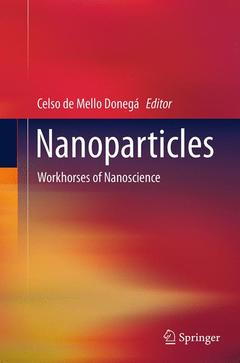Description
Nanoparticles, 2014
Workhorses of Nanoscience
Language: English
Publication date: 09-2016
Support: Print on demand
Publication date: 11-2014
299 p. · 15.5x23.5 cm · Hardback
Description
/li>Contents
/li>Biography
/li>Comment
/li>
This book can be roughly divided into three parts: fundamental physico-chemical and physical principles of Nanoscience, chemistry and synthesis of nanoparticles, and techniques to study nanoparticles. The first chapter is concerned with the origin of the size dependence of the properties of nanomaterials, explaining it in terms of two fundamental nanoscale effects. This chapter also serves as a general introduction to the book, briefly addressing the definition and classification of nanomaterials and the techniques used to fabricate and study them. Chapter 2 lays out the theoretical framework within which to understand size effects on the properties of semiconductor nanocrystals, with particular emphasis on the quantum confinement effect. The optical properties of metal nanoparticles and metal nanostructures (periodic lattices) are discussed in Chapter 3. Chapter 4 is devoted to nanoporous materials, treating in detail their synthesis, structure and functional properties, as well as the physical properties of liquids confined in nanopores. The preparation methods, characterization techniques, and applications of supported nanoparticles are covered in Chapter 5. The sixth Chapter presents the essential physical-chemical concepts needed to understand the preparation of colloidal inorganic nanoparticles, and the remarkable degree of control that has been achieved over their composition, size, shape and surface. The last four Chapters are dedicated to a few selected characterization techniques that are very valuable tools to study nanoparticles. Chapter 7 concentrates on electron microscopy techniques, while Chapter 8 focuses on scanning probe microscopy and spectroscopy. Electron paramagnetic resonance (EPR) based spectroscopic techniques and their application to nanoparticles are explored in Chapter 9. Finally, Chapter 10 shows how solution Nuclear Magnetic Resonance (NMR) spectroscopic techniques can be used to unravel the surface chemistry of colloidal nanoparticles.
The Nanoscience Paradigm: “Size Matters!”.- Size effects on semiconductor nanoparticles.- Metal nanoparticles for microscopy and spectroscopy.- Nanoporous materials and confined liquids.- Supported nanoparticles.- The challenge of colloidal nanoparticle synthesis.- Electron microscopy techniques.- Scanning probe microscopy and spectroscopy.- Electron paramagnetic resonance based spectroscopic techniques.- Solution NMR toolbox for colloidal nanoparticles.
Useful for graduate students with additional exercises
Presents new potential applications of Nanomaterials
Provides the essential background of the field
Includes supplementary material: sn.pub/extras




